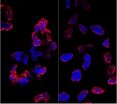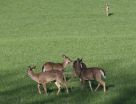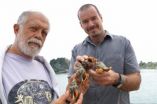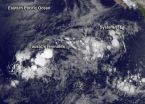(Press-News.org) LA JOLLA-The ability to switch out one gene for another in a line of living stem cells has only crossed from science fiction to reality within this decade. As with any new technology, it brings with it both promise--the hope of fixing disease-causing genes in humans, for example--as well as questions and safety concerns. Now, Salk scientists have put one of those concerns to rest: using gene-editing techniques on stem cells doesn't increase the overall occurrence of mutations in the cells. The new results were published July 3 in the journal Cell Stem Cell.
"The ability to precisely modify the DNA of stem cells has greatly accelerated research on human diseases and cell therapy," says senior author Juan Carlos Izpisua Belmonte, professor in Salk's Gene Expression Laboratory. "To successfully translate this technology into the clinic, we first need to scrutinize the safety of these modified stem cells, such as their genome stability and mutational load."
When scientists want to change the sequence of a stretch of DNA inside cells--either for research purposes or to fix a genetic mutation for therapeutic purposes--they have their choice of two methods. They can use an engineered virus to deliver the new gene to a cell; the cell then integrates the new DNA sequence in place of the old one. Or scientists can use what's known as custom targeted nucleases, such as TALEN proteins, which cut DNA at any desired location. Researchers can use the proteins to cut a gene they want to replace, then add a new gene to the mix. The cell's natural repair mechanisms will paste the new gene in place.
Previously, Belmonte's lab had pioneered the use of modified viruses, called helper-dependent adenoviral vectors (HDAdVs) to correct the gene mutation that causes sickle cell disease, one of the most severe blood diseases in the world. He and his collaborators used HDAdVs to replace the mutated gene in a line of stem cells with a mutant-free version, creating stem cells that could theoretically be infused into patients' bone marrow so that their bodies create healthy blood cells.
Before such technologies are applied to humans, though, researchers like Belmonte wanted to know whether there were risks of editing the genes in stem cells. Even though both common gene-editing techniques have been shown to be accurate at altering the right stretch of DNA, scientists worried that the process could make the cells more unstable and prone to mutations in unrelated genes--such as those that could cause cancer.
"As cells are being reprogrammed into stem cells, they tend to accumulate many mutations," says Mo Li, a postdoctoral fellow in Belmonte's lab and an author of the new paper. "So people naturally worry that any process you perform with these cells in vitro--including gene editing--might generate even more mutations."
To find out whether this was the case, Belmonte's group, in collaboration with BGI and the Institute of Biophysics, Chinese Academy of Sciences in China, turned to a line of stem cells containing the mutated gene that causes sickle cell disease. They edited the genes of some cells using one of two HDAdV designs, edited others using one of two TALEN proteins, and kept the rest of the cells in culture without editing them. Then, they fully sequenced the entire genome of each cell from the four edits and control experiment.
While all of the cells gained a low level of random gene mutations during the experiments, the cells that had undergone gene-editing--whether through HDAdV- or TALEN-based approaches--had no more mutations than the cells kept in culture.
"We were pleasantly surprised by the results," Keiichiro Suzuki, a postdoctoral fellow in Belmonte's lab and an author of the study, says. "People have found thousands of mutations introduced during iPSC reprogramming. We found less than a hundred single nucleotide variants in all cases."
The finding, Li adds, doesn't necessarily mean that there are no inherent risks to using stem cells with edited genes, but that the editing process doesn't make the stem cells any less safe.
"We concluded that the risk of mutation isn't inherently connected to gene editing," he says. "These cells present the same risks as using any other cells manipulated for cell or gene therapy." He adds that two other papers published in the same issue support their results (one by Johns Hopkins University and one from Harvard University and collaborators).
The Belmonte group is planning more studies to address whether gene-repair in other cell types, using other approaches, or targeting other genes could be more or less likely to cause unwanted mutations. For now, they hope their findings encourage those in the field to keep pursuing gene-editing techniques as a potential way to treat genetic diseases in the future.
Other researchers on the study were Jing Qu, April Goebl, Emi Aizawa, Rupa Devi Soligalla, Jessica Kim, Na Young Kim, Hsin-Kai Liao, Chris Benner, and Concepcion Rodriguez Esteban of the Salk Institute for Biological Studies; Chang Yu, Xiaotian Yao, Senwei Tang, Fan Zhang, Feng Chen, Yabin Jin, and Yingrui Li of BGI; and Jing Qu,Tingting Yuan, Ruotong Ren, Xiuling Xu, and Guang-Hui Liu of the Institute of Biophysics, Chinese Academy of Sciences.
The work was supported by the G. Harold and Leila Y. Mathers Charitable Foundation, the Leona M. and Harry B. Helmsley Charitable Trust, the Glenn Foundation, the California Institute of Regenerative Medicine, the National Institutes of Health, the Chinese Academy of Sciences, the Beijing Natural Science Foundation, and the Thousand Young Talents program of China.
INFORMATION:
About the Salk Institute for Biological Studies
The Salk Institute for Biological Studies is one of the world's preeminent basic research institutions, where internationally renowned faculty probes fundamental life science questions in a unique, collaborative and creative environment. Focused both on discovery and on mentoring future generations of researchers, Salk scientists make groundbreaking contributions to our understanding of cancer, aging, Alzheimer's, diabetes and infectious diseases by studying neuroscience, genetics, cell and plant biology, and related disciplines.
Faculty achievements have been recognized with numerous honors, including Nobel Prizes and memberships in the National Academy of Sciences. Founded in 1960 by polio vaccine pioneer Jonas Salk, MD, the Institute is an independent nonprofit organization and architectural landmark.
No extra mutations in modified stem cells, study finds
New results ease previous concerns that gene-editing techniques used to develop therapies for genetic diseases could add unwanted mutations to stem cells
2014-07-09
ELSE PRESS RELEASES FROM THIS DATE:
Hunting gives deer-damaged forests in state parks a shot at recovery
2014-07-09
WEST LAFAYETTE, Ind. - Regulated deer hunts in Indiana state parks have helped restore the health of forests suffering from decades of damage caused by overabundant populations of white-tailed deer, a Purdue study shows.
A research team led by Michael Jenkins, associate professor of forest ecology, found that a 17-year-long Indiana Department of Natural Resources policy of organizing hunts in state parks has successfully spurred the regrowth of native tree seedlings, herbs and wildflowers rendered scarce by browsing deer.
Jenkins said that while hunting may be unpopular ...
Protein pushes breast cancer cells to metastasize
2014-07-09
Using an innovative tool that captures heretofore hidden ways that cells are regulated, scientists at Rockefeller University have identified a protein that makes breast cancer cells more likely to metastasize.
What's more, the protein appears to trigger cancer's spread in part by blocking two other proteins that are normally linked to neurodegeneration, a finding that suggests these two disease processes could have unexpected ties.
The study, which appears in the July 10 issue of Nature, points to the possibility of new cancer therapies that target this "master regulator" ...
Not at home on the range
2014-07-09
As climate change shifts the geographic ranges in which animals can be found, concern mounts over the effect it has on their parasites. Does an increased range for a host mean new territory for its parasites as well?
Not necessarily, says a team of UC Santa Barbara scientists, including parasitologists Ryan Hechinger and Armand Kuris. In a study published in the Journal of Biogeography, Hechinger, Kuris and colleagues show that for some species, the opposite may happen: Hosts may actually lose their parasites when the hosts shift or increase their range. Theirs is one ...
New system would give individuals more control over shared digital data
2014-07-09
Cellphone metadata has been in the news quite a bit lately, but the National Security Agency isn't the only organization that collects information about people's online behavior. Newly downloaded cellphone apps routinely ask to access your location information, your address book, or other apps, and of course, websites like Amazon or Netflix track your browsing history in the interest of making personalized recommendations.
At the same time, a host of recent studies have demonstrated that it's shockingly easy to identify unnamed individuals in supposedly "anonymized" data ...
NASA, NOAA satellites help confirm Tropical Storm Fausto as a remnant low
2014-07-09
NOAA's GOES-West and NASA-JAXA's Global Precipitation Measurement or GPM mission satellite helped forecasters at the National Hurricane Center determine that what was once Tropical Storm Fausto is now a remnant area of low pressure in the Eastern Pacific Ocean.
Forecaster Beven at the National Hurricane Center (NHC) noted that "satellite imagery, overnight scatterometer data, and a recent GPM satellite microwave overpass indicate that Fausto has degenerated to a trough of low pressure."
On July 9 at 1500 UTC (11 a.m. EDT) Fausto's circulation was no longer apparent ...
Study identifies novel genomic changes in the most common type of lung cancer
2014-07-09
Researchers from The Cancer Genome Atlas (TCGA) Research Network have identified novel mutations in a well-known cancer-causing pathway in lung adenocarcinoma, the most common subtype of lung cancer. Knowledge of these genomic changes may expand the number of possible therapeutic targets for this disease and potentially identify a greater number of patients with treatable mutations because many potent cancer drugs that target these mutations already exist.
TCGA is jointly funded and managed by the National Cancer Institute (NCI) and the National Human Genome Research ...
Study cracks how the brain processes emotions
2014-07-09
ITHACA, N.Y. – Although feelings are personal and subjective, the human brain turns them into a standard code that objectively represents emotions across different senses, situations and even people, reports a new study by Cornell University neuroscientist Adam Anderson.
"We discovered that fine-grained patterns of neural activity within the orbitofrontal cortex, an area of the brain associated with emotional processing, act as a neural code which captures an individual's subjective feeling," says Anderson, associate professor of human development in Cornell's College ...
Bacteria hijack plentiful iron supply source to flourish
2014-07-09
In an era of increasing concern about the prevalence of antibiotic-resistant illness, Case Western Reserve researchers have identified a promising new pathway to disabling disease: blocking bacteria's access to iron in the body.
The scientists showed how bacterial siderophore, a small molecule, captures iron from two abundant supply sources to fan bacterial growth — as well as how the body launches a chemical counterassault against this infection process. Their findings appear in a recent edition of The Journal of Experimental Medicine.
"Bacterial siderophore will be ...
Climate change provides good growing conditions for charcoal rot in soybeans
2014-07-09
URBANA, Ill. – With over 100 diseases that can attack soybean crops, why would charcoal rot rise to the top of the most wanted list? University of Illinois scientists cite the earth's changing climate as one reason that more research is needed on the fungus that causes charcoal rot.
Fungi may often be associated with cool, damp growing conditions but Macrophomina phaseolina, the fungus that causes charcoal rot, prefers hot and dry drought conditions.
"As the climate continues to change and we see more extremes in the weather, including hotter, drier summers, this fungus ...
Biologists link sexual selection and placenta formation
2014-07-09
RIVERSIDE, Calif. — Sexual selection refers to species' selection for traits that are attractive to the opposite sex. This special type of natural selection enhances opportunities to mate, the tail of male peacocks being an iconic example.
Biologists at the University of California, Riverside have now found that sexual selection and "placentation" — the formation of a placenta — are linked. Describing the life histories of more than 150 species of fish in the family Poeciliidae, the researchers found that species with placentas tend to have males that do not have bright ...
LAST 30 PRESS RELEASES:
New science reporting guide published for journalists in Bulgaria
New international study reveals major survival gaps among children with cancer
New science reporting guide published for journalists in Turkey
Scientists develop a smarter mRNA therapy that knows which cells to target
Neuroanatomy-informed brain–machine hybrid intelligence for robust acoustic target detection
Eight SwRI hydrogen projects funded by ENERGYWERX
The Lundquist Institute and its start-up company Vitalex Biosciences Announces Strategic Advancement of Second-Generation fungal Vaccine VXV-01 through Phase 1 Trials under $40 Million Competitive Con
Fine particles in pollution are associated with early signs of autoimmune disease
Review article | Towards a Global Ground-Based Earth Observatory (GGBEO): Leveraging existing systems and networks
Penn and UMich create world’s smallest programmable, autonomous robots
Cleveland researchers launch first major study to address ‘hidden performance killer’ in athletes
To connect across politics, try saying what you oppose
Modulating key interaction prevents virus from entering cells
Project explores barriers to NHS career progression facing international medical graduates
Jeonbuk National University researchers explore the impact of different seasonings on the flavor perception of Doenjang soup
Two Keck Medicine of USC Hospitals named Leapfrog Top Teaching Hospitals
World-first discovery uncovers how glioblastoma tumours dodge chemotherapy, potentially opening the door to new treatments
A fatal mix-up: How certain gut bacteria drive multiple sclerosis
New AI tool identifies not just genetic mutations, but the diseases they may cause
Deep-learning model predicts how fruit flies form, cell by cell
Combination pills for high blood pressure may simplify treatment, improve long-term health
Immune system keeps mucosal fungi in check
Neurons within the brain use simple rules to localize genetic messages
Electrodes created using light
Second-hand gift-giving is a well-deliberated decision
How human interaction drove evolution to make bears less aggressive
National Poll: Few parents offer teens guidance on healthy eating during holiday season
Cannabis derivatives could provide new ovarian cancer treatments
Raising strong yeast as a petroleum substitute
Clues to the origin of hot Jupiters hidden in their orbits
[Press-News.org] No extra mutations in modified stem cells, study findsNew results ease previous concerns that gene-editing techniques used to develop therapies for genetic diseases could add unwanted mutations to stem cells







